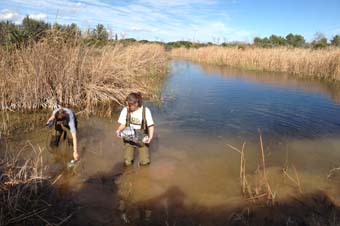
A group of researchers from the Cavanilles Institute for Biodiversity and Evolutionary Biology of the University of Valencia, led by Professor Antonio Camacho, is studying the main types of Iberian wetlands aiming to assess their potential as carbon sinks and, this way, improve their management and reinforce their action on climate change mitigation.
This work, developed in collaboration with the Spanish Office for Climate Change of the Ministry of Agriculture, Food and Environment, has been financed 50% by the University of Valencia and the Biodiversity Foundation with a total amount of 59.000 euros. Research will continue during 2015 through a project that will evaluate the main factors affecting the capacity of carbon sequestration of these ecosystems.
Professor Antonio Camacho highlights that the analyses already performed in this project, called Carbonsink, have shown the importance of preserving the good environmental status of wetlands to “guarantee their role in atmospheric carbon sequestration, as well as to reduce emissions of methane, a gas with a greenhouse effect capacity that is much more powerful than CO2”.
The research conducted by the University of Valencia has also identified key factors in the regulation of the carbon cycle in wetlands, such as temperature, water salinity, the flood level and the concentration of elements that have the capacity of acting as fertilizers. Some of these, as Camacho indicates, “can be modified in several ways with good management and restoration practices that improve the conservation status of ecosystems and that, at the same time, enhance carbon sequestration to mitigate climate change”. The project starting this month, Carbopractic, will monitor these variables and will make it possible to design adjustments with environmental management models.
Carbonsink has focused on the two types of wetlands that are most common in the Iberian Peninsula: on the one hand, coastal marshes —one of the most characteristic Valencian ecosystems— and, concretely, the Marjal dels Moros and the Marjal de Pego-Oliva; and on the other hand, saline lakes, among which some from La Mancha Húmeda Biosphere Reserve were chosen. In fact, these are among the most important inland wetlands and are a peninsular paradigm in the European context. Furthermore, they have also been selected because salinity, as it has been proven, can play a key function in the regulation of methane emission.
VERY ACTIVE BIOLOGICALLY
Wetlands are among the most biologically active ecosystems in the planet, and, despite their relatively small surface in comparison with other types of natural areas, they play a fundamental role in the biogeochemical cycles at the global level and, in consequence, their conservation and good management can contribute to mitigate climate change.
The Limnology group of the Cavanilles Institute for Biodiversity and Evolutionary Biology of the University of Valencia has a long background in studying the ecology of aquatic ecosystems. In this group, Professor Antonio Camacho and his team focus their investigations on the ecological patterns that govern the functioning of aquatic ecosystems, as well as the biodiversity that they harbour.
Last update: 20 de january de 2015 07:00.
News release



















